
AIOC
Ham Radio All-in-one-Cable
Stars: 1194
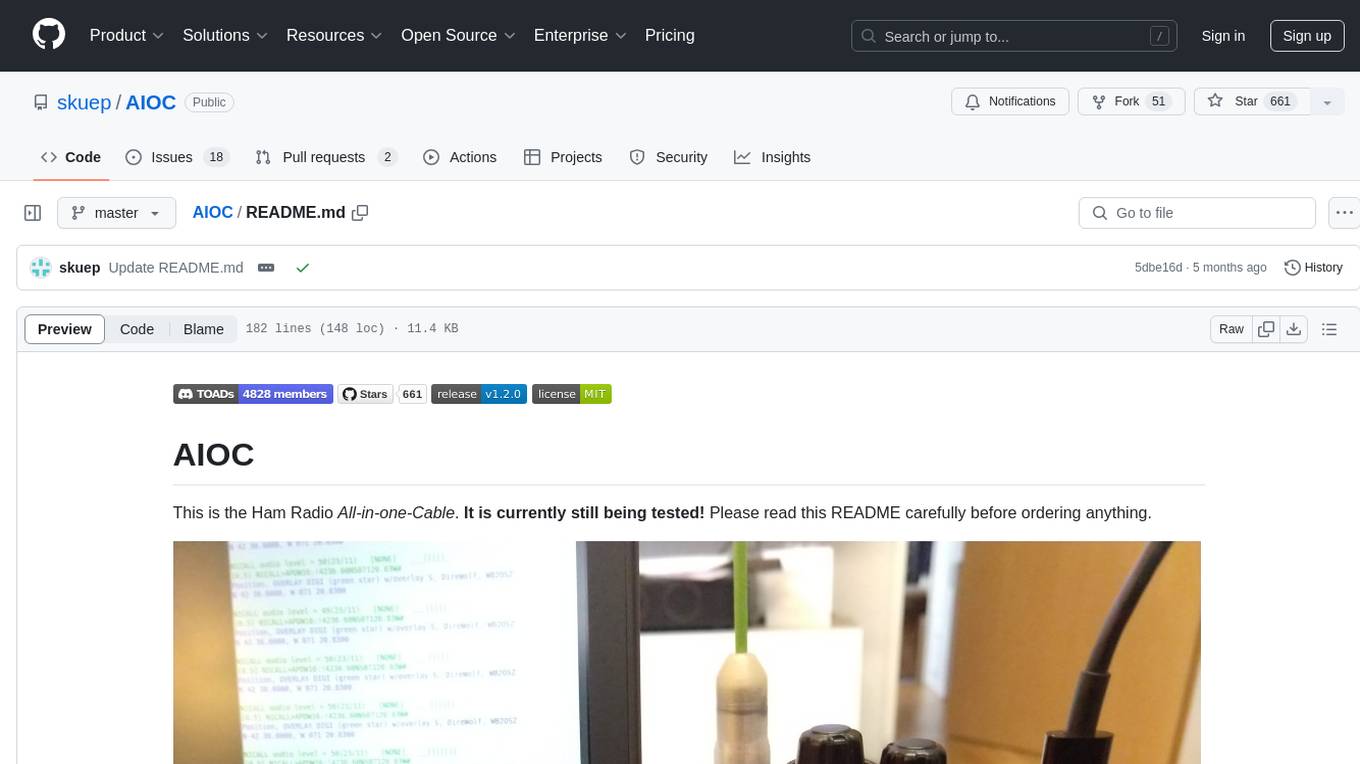
AIOC is an All-in-one-Cable for Ham Radio enthusiasts, providing a cheap and hackable digital mode USB interface with features like sound-card, virtual tty, and CM108 compatible HID endpoint. It supports various software and tested radios for functions like programming, APRS, and Dual-PTT HTs. Users can fabricate and assemble the AIOC using specific instructions, and program it using STM32CubeIDE. The tool can be used for tasks like programming radios, asserting PTT, and accessing audio data channels. Future work includes configurable AIOC settings, virtual-PTT, and virtual-COS features.
README:
This is the Ham Radio All-in-one-Cable. It is currently still being tested! Please read this README carefully before ordering anything.
The AIOC is a small adapter with a USB-C connector that enumerates itself as a sound-card (e.g. for APRS purposes), a virtual tty ("COM Port") for programming and asserting the PTT (Push-To-Talk) as well as a CM108 compatible HID endpoint for CM108-style PTT (new in firmware version 1.2.0).
You can watch the videos of the Temporarily Offline and HAM RADIO DUDE YouTube channels below.
There is also a German 4-part article with instructions here.
- Cheap & Hackable Digital mode USB interface (similar to digirig, mobilinkd, etc...)
- Programming Cable Function via virtual Serial Port
- Compact form-factor (DIY overmolded enclosure is currently TBD)
- Based on easy-to-hack STM32F302 with internal ADC/DAC (Programmable via USB bootloader using DFU)
- Can support Dual-PTT HTs
- Supports all popular OSes (Linux, Windows and MacOS with limitations [*])
- Direwolf as AX.25 modem/APRS en+decoder/...
- AllStarLink as ASL Node
- APRSdroid as APRS en+decoder
- CHIRP for programming
- VaraFM
- ... and more
- Wouxun UV-9D Mate (CHIRP + APRS)
- Baofeng UV-5R (CHIRP + APRS)
- BTECH 6X2 (CHIRP)
- Quansheng UV-K5 (Quansheng Dock, Egzumer or regular)
- Go to JLCPCB.com and upload the GERBER-k1-aioc.zip package (under
kicad/k1-aioc/jlcpcb)- Select PCB Thickness 1.2mm (that is what I recommend with the TRS connectors I used)
- You may want to select LeadFree HASL
- Select Silkscreen/Soldermask color to your liking
- Check "PCB Assembly"
- PCBA Type "Economic"
- Assembly Side "Top Side"
- Tooling Holes "Added by Customer"
- Press Confirm
- Click "Add BOM File" and upload
BOM-k1-aioc.csv - Click "Add CPL File" and upload
CPL-k1-aioc.csv - Press Next
- Look Through components, see if something is missing or problematic
- Make sure that all listed components are selected and press Next
- Check everything looks roughly good (rotations are already baked-in and should be correct). Save to Cart
This gives you 5 (or more) SMD assembled AIOC. The only thing left to do is soldering on the TRS connectors (see here). The total bill should be around 60$ US for 5 pieces plus tax and shipping from China.
Note that the following message from JLCPCB is okay and can be ignored.
The below parts won't be assembled due to data missing.
H1,H2 designators don't exist in the BOM file.
J2,D3,D4,R17 designators don't exist in the CPL file.
Note for people doing their own PCB production: I suggest using the LCSC part numbers in the BOM file as a guide on what to buy (especially regarding the MCU).
Note the current hardware version is 1.0, but there is a version 1.2 currently in the making here that will feature
- support for an external hardware input (e.g. for COS)
- a split pad for the PTT/UART contact, so in case you would like to use the AIOC hardware for another purpose than a K1-style connector, you can separate these two signals that are otherwise connected to the same TRS contact.
- Adjustable input and output audio levels (line-level, mic-level)
This is the process I use for building. See photographs in images folder.
- You need to use Monacor
PG-204PandPG-203Por compatible TRS connectors (2 solder lugs and a big tab for the sleeve connection). Adafruit products1800and1798are confirmed to work as well. - Cut the 2.5mm and 3.5mm TRS sleeve tab where the hole is located
- Put both TRS connectors into the 3d-printed solder guide (or a cheap HT that you don't mind potentially damaging). Make sure, that they are seated all the way in. If the holes in the solder guide are too small, you can ream them using a 2.5mm and 3.5mm drill bit.
- Insert the AIOC PCB into the solder guide
- Solder sleeve tab on the back side for both TRS connectors first
- Turn around PCB and solder remaining solder lugs
- Optionally you can 3D print a case for your AIOC. This model has been designed by a third party but is confirmed to work with the AIOC.
Note It is unfortunately quite common that the TRS connectors have intermittent contact after soldering the ring or tip tabs. In this case, it helps to re-melt the solder joint, then using e.g. tweezer slightly assert some sideways force onto the contact and let the solder joint solidify while applying the pressure on the contact. This will keep some tension on the area where the tab internally connects to the barrel and thus give a solid (spring loaded) connection.
For building the firmware, clone the repository and initialize the submodules. Create an empty workspace with the STM32CubeIDE and import the project.
git clone <repositry url>git submodule update --init- Start STM32CubeIDE and create a new workspace under
<project-root>/stm32 - Choose File->Import and import the
aioc-fwproject in the same folder without copying - Select Project->Build All and the project should build. Use the Release build unless you specifically want to debug an issue
The following steps are required for initial programming of the AIOC:
- Short outermost pins on the programming header. This will set the device into bootloader mode in the next step.

- Connect USB-C cable to the AIOC PCB
- Use a tool like
dfu-utilto program the firmware binary from the GitHub Releases page like this:
Note that adfu-util -a 0 -s 0x08000000:leave -D aioc-fw-x-y-z.binlibusbdriver is required for this. On Windows there are additional steps required as shown here (DFuSe Utility and dfu-util). On other operating systems (e.g. Linux, MacOS), this just works ™ (provided libusb is installed on your system). On Linux (and MacOS), your user either needs to have the permission to use libusb (plugdevgroup) or you might need to usesudo. - Remove short from first step, unplug and replug the device, it should now enumerate as the AIOC device
Once the AIOC has firmware loaded onto it, it can be re-programmed without the above BOOT sequence by following these steps.
Note This requires firmware version >= 1.2.0. For older firmwares, the initial programming sequence above is required for updating the firmware.
- Run
dfu-utillike thisdfu-util -d 1209:7388 -a 0 -s 0x08000000:leave -D aioc-fw-x-y-z.bin
This will reboot the AIOC into the bootloader automatically and perform the programming. After that, it automatically reboots the AIOC into the newly programmed firmware.
Note Should you find yourself with a bricked AIOC, use the initial programming sequence above
The serial interface of the AIOC enumerates as a regular COM (Windows) or ttyACM port (Linux) and can be used as such for programming the radio as well as PTT (Asserted on DTR=1 and RTS=0).
Note before firmware version 1.2.0, PTT was asserted by DTR=1 (ignoring RTS) which caused problems with certain radios when using the serial port for programming the radio e.g. using CHIRP.
The soundcard interface of the AIOC gives access to the audio data channels. It has one mono microphone channel and one mono speaker channel and currently supports the following baudrates:
- 48000 Hz (preferred)
- 32000 Hz
- 24000 Hz
- 22050 Hz (specifically for APRSdroid, has approx. 90 ppm of frequency error)
- 16000 Hz
- 12000 Hz
- 11025 Hz (has approx. 90 ppm of frequency error)
- 8000 Hz
Since firmware version 1.2.0, a CM108 style PTT interface is available for public testing. This interface works in parallel to the COM-port PTT. Direwolf on Linux is confirmed working, please report any issues. Note that currently, Direwolf reports some warnings when using the CM108 PTT interface on the AIOC. While they are annoying, they are safe to ignore and require changes in the upstream direwolf sourcecode. See https://github.com/wb2osz/direwolf/issues/448 for more details.
- Follow the regular setup guide with Direwolf to determine the correct audio device to use. For the serial and CM108 PTT interfaces on Linux, you need to set correct permissions on the ttyACM/hidraw devices. Consult Direwolf manual.
- Configure the device as follows
[...] ADEVICE plughw:<x>,0 # <- Linux ADEVICE x 0 # <- Windows ARATE 48000 [...] PTT CM108 # <- Use the new CM108 compatible style PTT interface PTT <port> DTR -RTS # <- Alternatively use an old school serial device for PTT [...]
Once your cable is emulating a CM108, it becomes quite simple to plug into your HT and setup a simple simplex AllStarLink node that talks to your favorite repeater or node.
In asl-menu, set:
- Device type:
usbradio(menu sections: 2 > A1 > N4 > I2) - Duplex type:
1(menu sections: 2 > A1 > N5)
Edit usbradio.conf (menu sections: 6 > H) (for a Puxing PX-888 cheap Chineese HT)
rxboost = 0rxsqhyst = 500carrierfrom = usbinvertctcssfrom = norxdemod = speakertxprelim = noinvertptt = no
APRSdroid support has been added by AIOC by implementing support for the fixed 22050 Hz sample rate that APRSdroid requires. It is important to notice, that the exact sample rate can not be achieved by the hardware, due to the 8 MHz crystal. The actual sample rate used is 22052 Hz (which represents around 90 ppm of error). From my testing this does not seem to be a problem for APRS at all.
However, since APRSdroid does not have any PTT control, sending data is currently not possible using the AIOC except using the radio VOX function. See https://github.com/ge0rg/aprsdroid/issues/324. My previous experience is, that the Android kernel brings support for ttyACM devices (which is perfect for the AIOC) so implementing this feature for APRSdroid should theoretically be no problem.
Ideas such as implementing a digital-modes-spefic VOX-emulation to workaround this problem and let the AIOC activate the PTT automatically are currently being considered. Voice your opinion and ideas in the GitHub issues if this seems interesting to you.
CHIRP is a very popuplar open-source programming software that supports a very wide array of HT radios. You can use CHIRP just as you would like with a regular programming cable.
Download:
- Start CHIRP
- Select Radio->Download from Radio
- Select the AIOC COM/ttyACM port and start
Upload:
- Select Radio->Upload to Radio
- That's it
Select "DTR only" for PTT Pin, so that the correct RTS/DTR sequence is generated for PTT
There are known issues with EMI, when using a handheld radio with a monopole (i.e. stock) antenna. In this case, the USB cable will (inadvertently) work as a tiger-tail (counterpoise) and thus, high RF currents go through the USB lines which cause issues with the USB connection. Some people have connected cables between the radio and the AIOC and put a ferrite core on those wires, which seems to reduce those issues. I am trying to find out, which of the wires between the radio and the AIOC produce the problem, so that we might add SMD ferrites on the AIOC in the future
I encourage you to check for Pre-Releases announcing upcoming features. Currently we are working on
- Configurable AIOC: Change the way the PTT is asserted or the USB VID:PID that the AIOC uses using a Python script. These settings can be stored on the AIOC.
- Virtual-PTT: This feature allows your AIOC to be configured to automatically assert the PTT line when it receives TX data from your PC.
- Virtual-COS: The AIOC will notify your PC (e.g. using CM108 emulation) that there is audio data on the microphone input.
For Tasks:
Click tags to check more tools for each tasksFor Jobs:
Alternative AI tools for AIOC
Similar Open Source Tools

AIOC
AIOC is an All-in-one-Cable for Ham Radio enthusiasts, providing a cheap and hackable digital mode USB interface with features like sound-card, virtual tty, and CM108 compatible HID endpoint. It supports various software and tested radios for functions like programming, APRS, and Dual-PTT HTs. Users can fabricate and assemble the AIOC using specific instructions, and program it using STM32CubeIDE. The tool can be used for tasks like programming radios, asserting PTT, and accessing audio data channels. Future work includes configurable AIOC settings, virtual-PTT, and virtual-COS features.
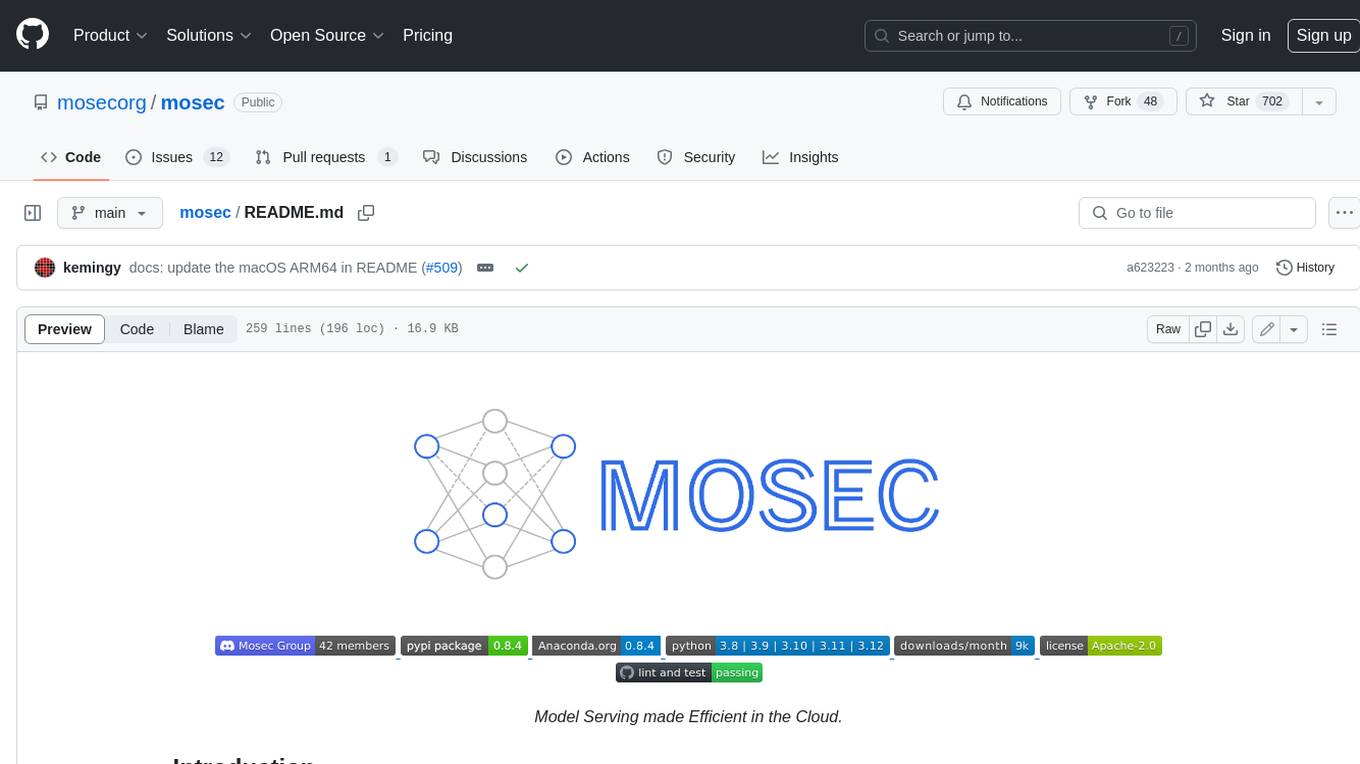
mosec
Mosec is a high-performance and flexible model serving framework for building ML model-enabled backend and microservices. It bridges the gap between any machine learning models you just trained and the efficient online service API. * **Highly performant** : web layer and task coordination built with Rust 🦀, which offers blazing speed in addition to efficient CPU utilization powered by async I/O * **Ease of use** : user interface purely in Python 🐍, by which users can serve their models in an ML framework-agnostic manner using the same code as they do for offline testing * **Dynamic batching** : aggregate requests from different users for batched inference and distribute results back * **Pipelined stages** : spawn multiple processes for pipelined stages to handle CPU/GPU/IO mixed workloads * **Cloud friendly** : designed to run in the cloud, with the model warmup, graceful shutdown, and Prometheus monitoring metrics, easily managed by Kubernetes or any container orchestration systems * **Do one thing well** : focus on the online serving part, users can pay attention to the model optimization and business logic
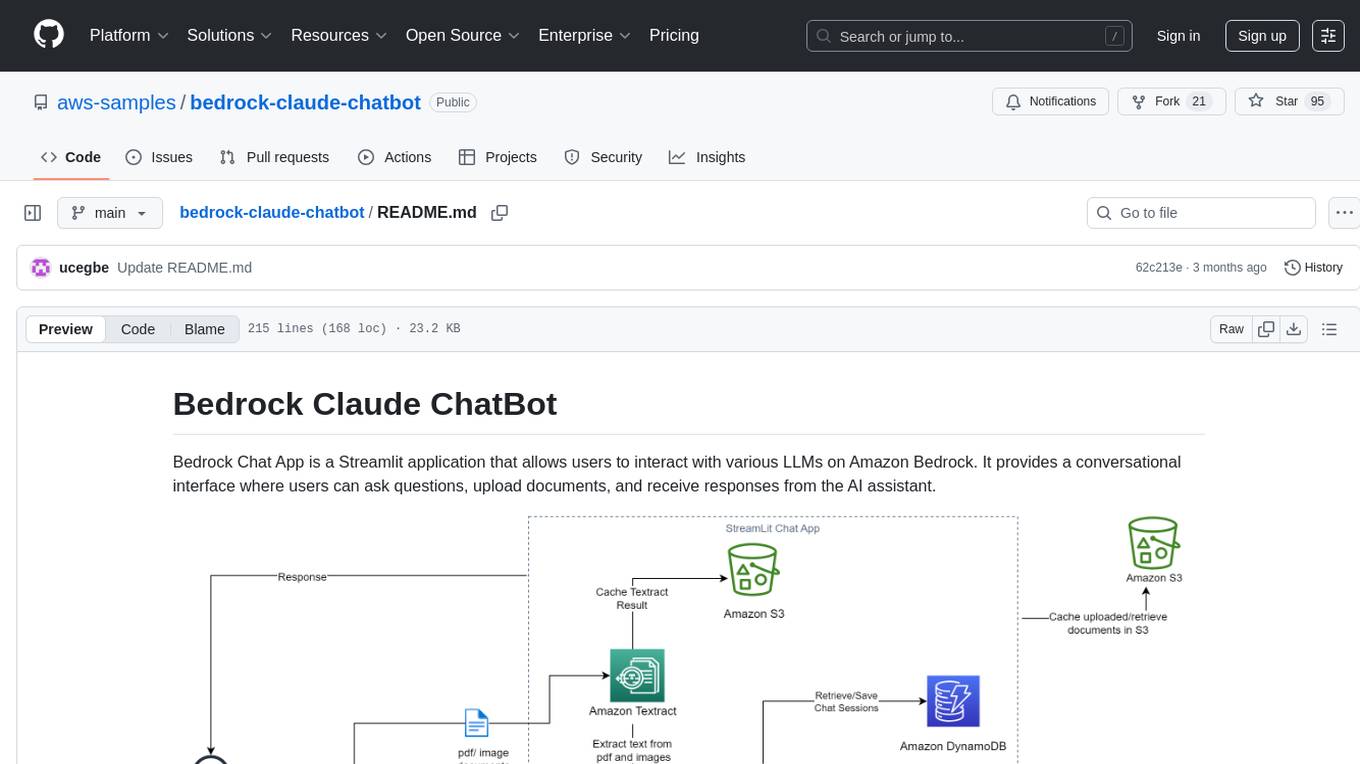
bedrock-claude-chatbot
Bedrock Claude ChatBot is a Streamlit application that provides a conversational interface for users to interact with various Large Language Models (LLMs) on Amazon Bedrock. Users can ask questions, upload documents, and receive responses from the AI assistant. The app features conversational UI, document upload, caching, chat history storage, session management, model selection, cost tracking, logging, and advanced data analytics tool integration. It can be customized using a config file and is extensible for implementing specialized tools using Docker containers and AWS Lambda. The app requires access to Amazon Bedrock Anthropic Claude Model, S3 bucket, Amazon DynamoDB, Amazon Textract, and optionally Amazon Elastic Container Registry and Amazon Athena for advanced analytics features.
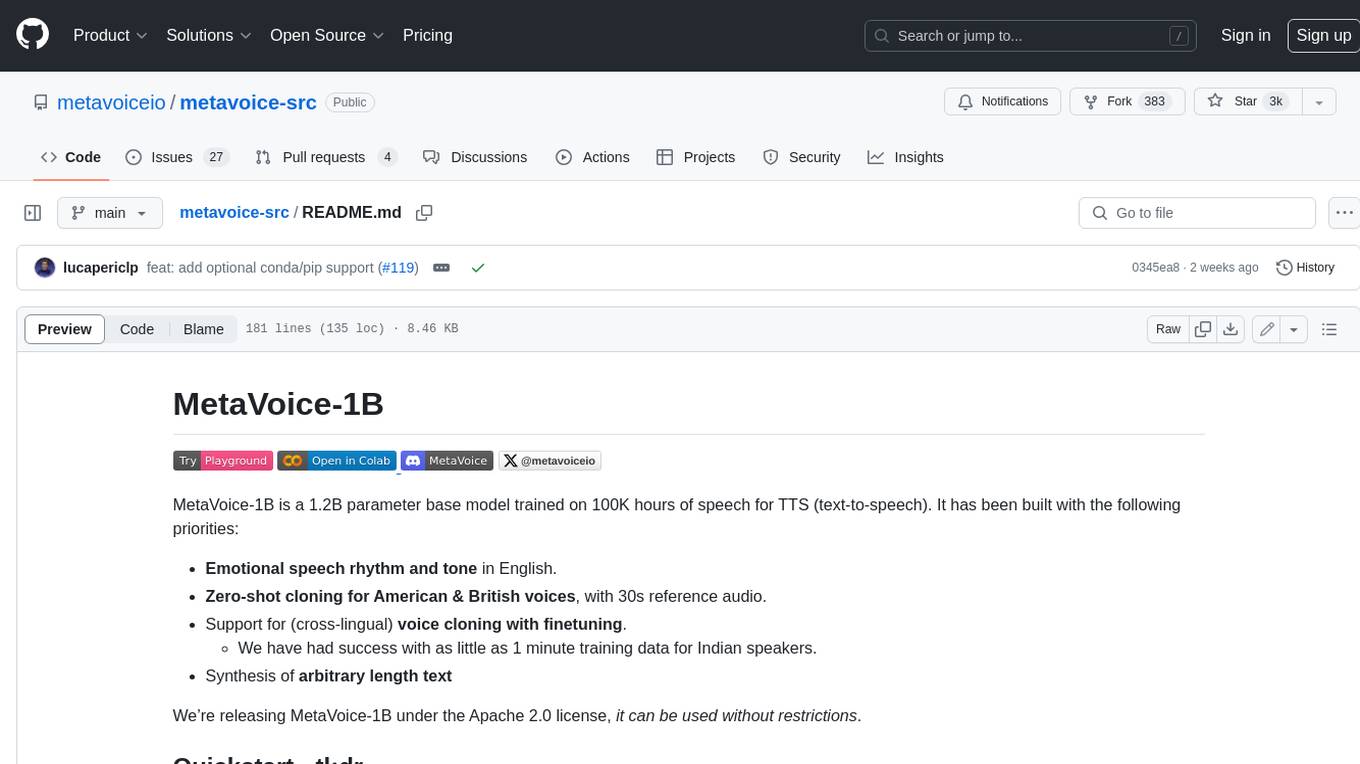
metavoice-src
MetaVoice-1B is a 1.2B parameter base model trained on 100K hours of speech for TTS (text-to-speech). It has been built with the following priorities: * Emotional speech rhythm and tone in English. * Zero-shot cloning for American & British voices, with 30s reference audio. * Support for (cross-lingual) voice cloning with finetuning. * We have had success with as little as 1 minute training data for Indian speakers. * Synthesis of arbitrary length text
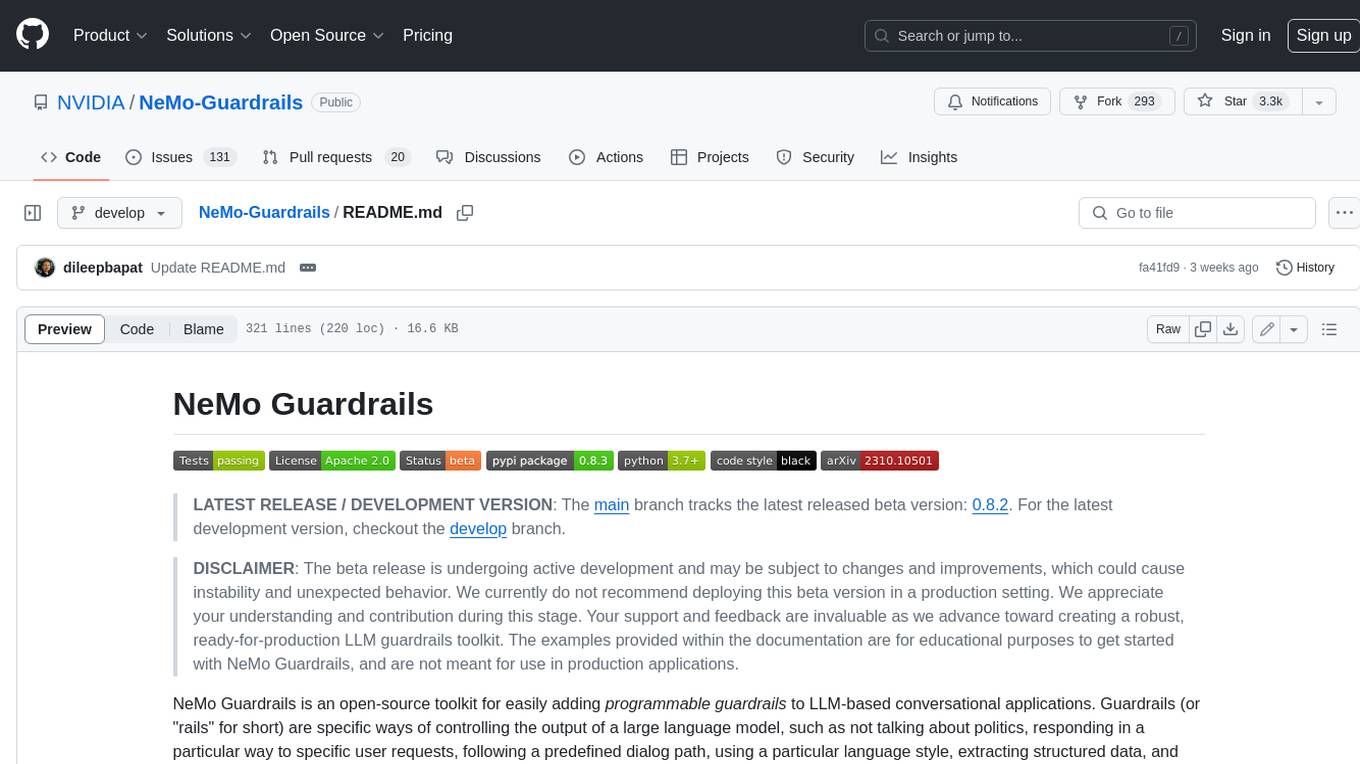
Guardrails
Guardrails is a security tool designed to help developers identify and fix security vulnerabilities in their code. It provides automated scanning and analysis of code repositories to detect potential security issues, such as sensitive data exposure, injection attacks, and insecure configurations. By integrating Guardrails into the development workflow, teams can proactively address security concerns and reduce the risk of security breaches. The tool offers detailed reports and actionable recommendations to guide developers in remediation efforts, ultimately improving the overall security posture of the codebase. Guardrails supports multiple programming languages and frameworks, making it versatile and adaptable to different development environments. With its user-friendly interface and seamless integration with popular version control systems, Guardrails empowers developers to prioritize security without compromising productivity.
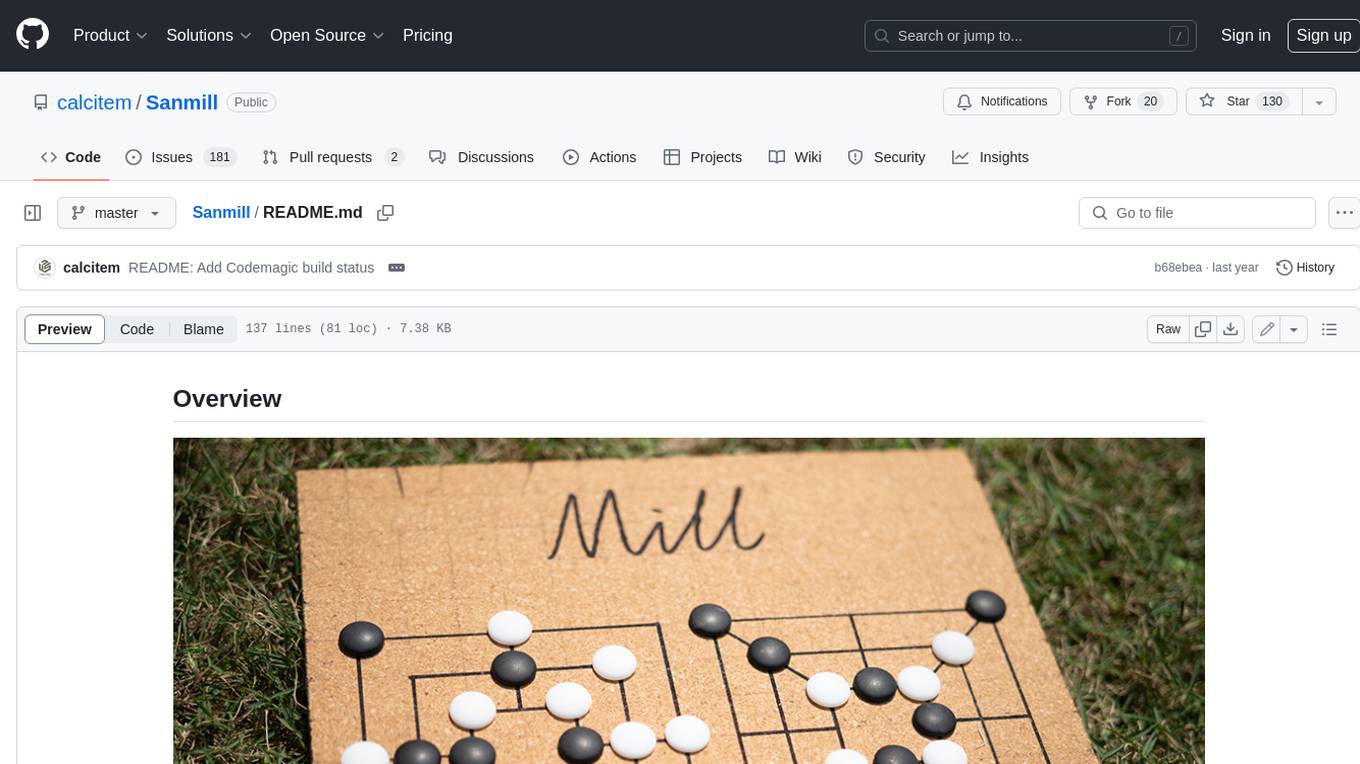
Sanmill
Sanmill is a free, powerful UCI-like N men's morris program with CUI, Flutter GUI and Qt GUI. Nine men's morris is a strategy board game for two players dating at least to the Roman Empire. The game is also known as nine-man morris , mill , mills , the mill game , merels , merrills , merelles , marelles , morelles , and ninepenny marl in English.
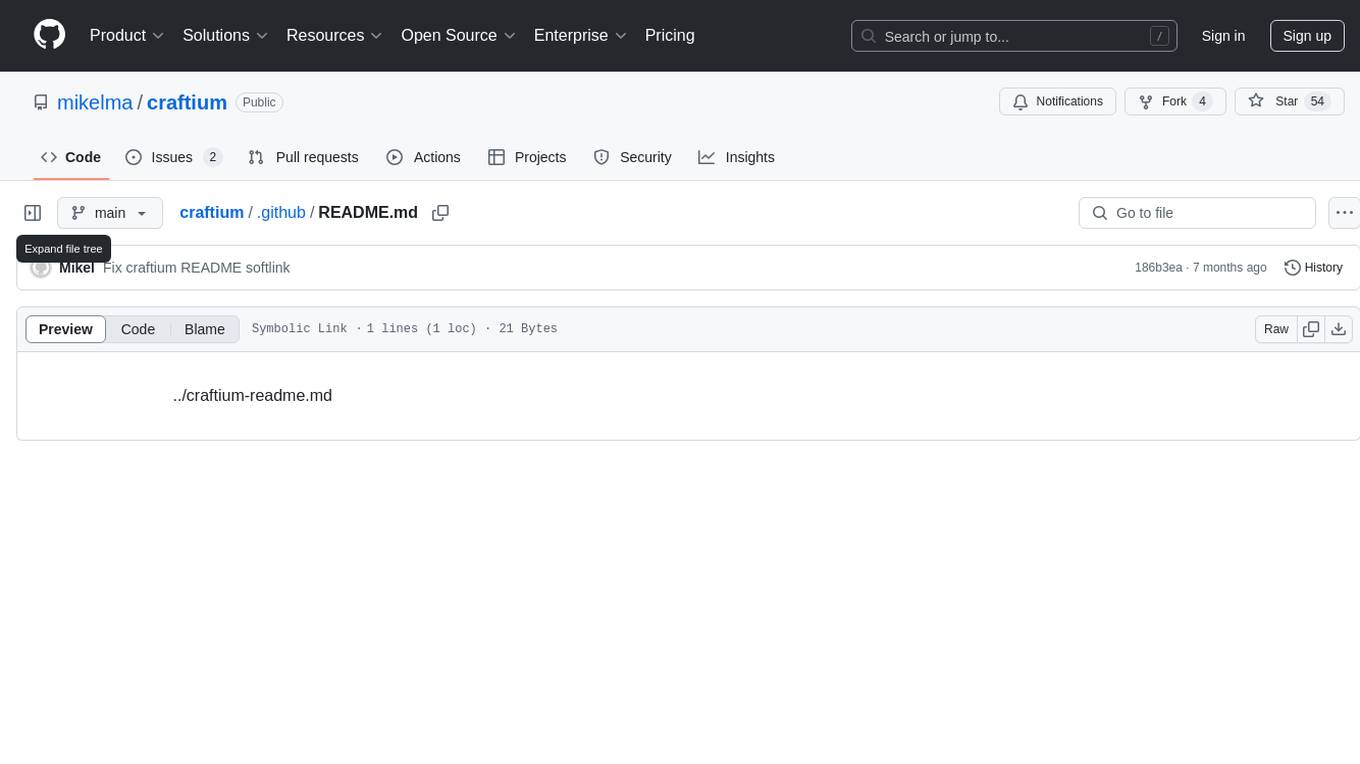
craftium
Craftium is an open-source platform based on the Minetest voxel game engine and the Gymnasium and PettingZoo APIs, designed for creating fast, rich, and diverse single and multi-agent environments. It allows for connecting to Craftium's Python process, executing actions as keyboard and mouse controls, extending the Lua API for creating RL environments and tasks, and supporting client/server synchronization for slow agents. Craftium is fully extensible, extensively documented, modern RL API compatible, fully open source, and eliminates the need for Java. It offers a variety of environments for research and development in reinforcement learning.
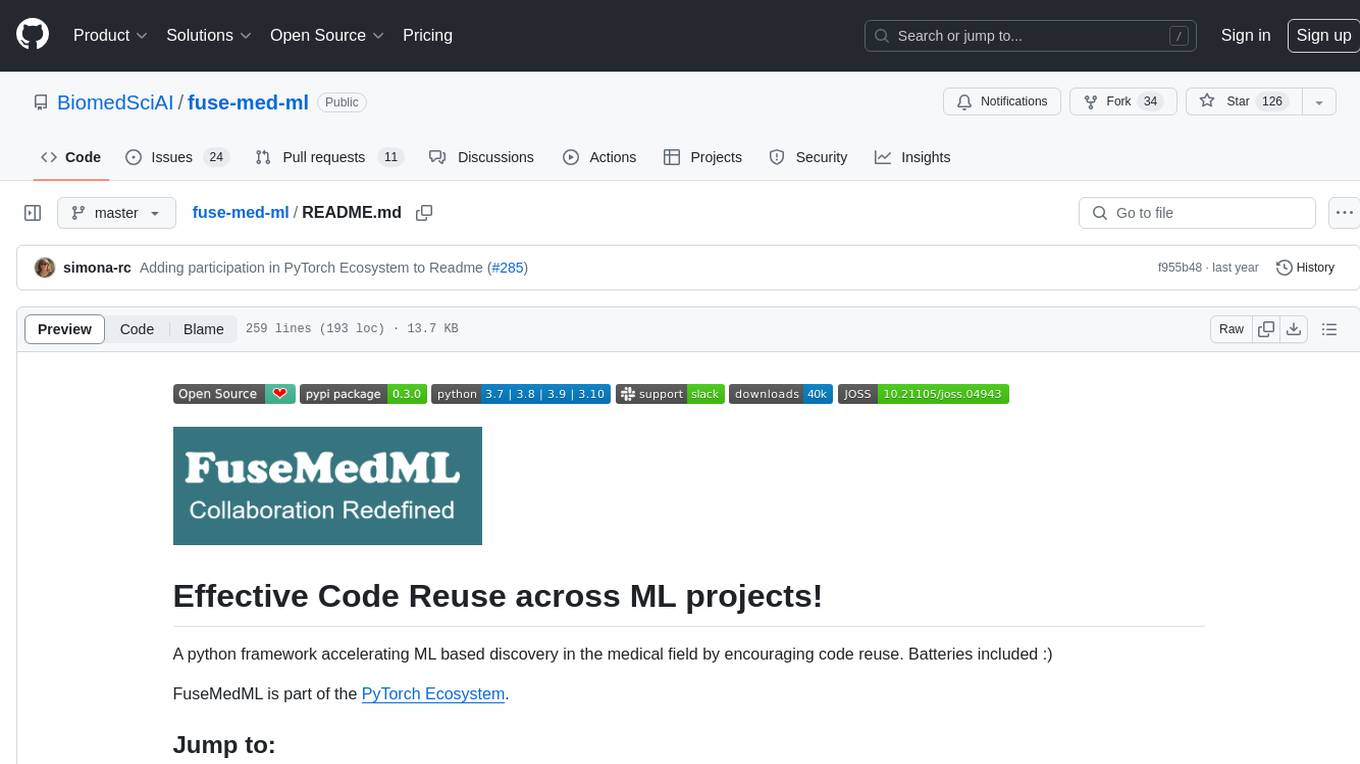
fuse-med-ml
FuseMedML is a Python framework designed to accelerate machine learning-based discovery in the medical field by promoting code reuse. It provides a flexible design concept where data is stored in a nested dictionary, allowing easy handling of multi-modality information. The framework includes components for creating custom models, loss functions, metrics, and data processing operators. Additionally, FuseMedML offers 'batteries included' key components such as fuse.data for data processing, fuse.eval for model evaluation, and fuse.dl for reusable deep learning components. It supports PyTorch and PyTorch Lightning libraries and encourages the creation of domain extensions for specific medical domains.
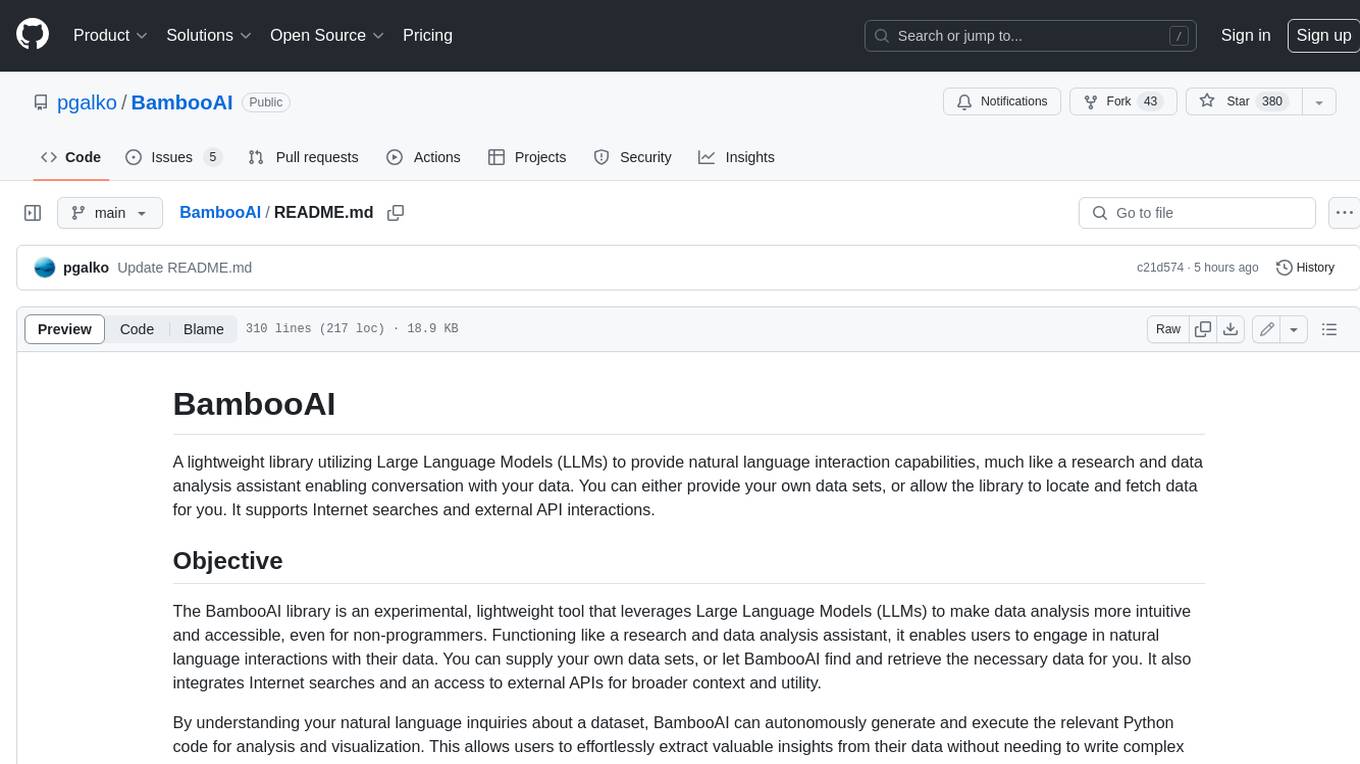
BambooAI
BambooAI is a lightweight library utilizing Large Language Models (LLMs) to provide natural language interaction capabilities, much like a research and data analysis assistant enabling conversation with your data. You can either provide your own data sets, or allow the library to locate and fetch data for you. It supports Internet searches and external API interactions.
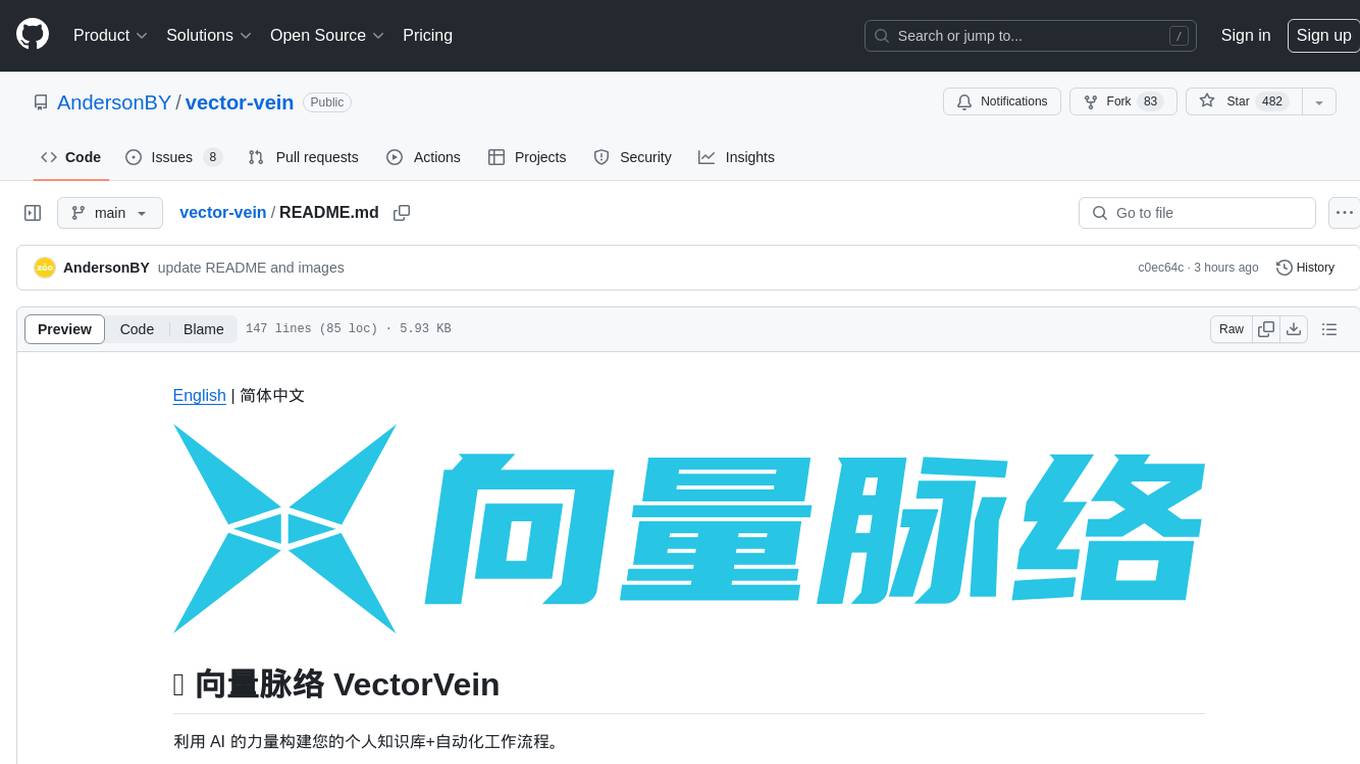
vector-vein
VectorVein is a no-code AI workflow software inspired by LangChain and langflow, aiming to combine the powerful capabilities of large language models and enable users to achieve intelligent and automated daily workflows through simple drag-and-drop actions. Users can create powerful workflows without the need for programming, automating all tasks with ease. The software allows users to define inputs, outputs, and processing methods to create customized workflow processes for various tasks such as translation, mind mapping, summarizing web articles, and automatic categorization of customer reviews.

kaito
Kaito is an operator that automates the AI/ML inference model deployment in a Kubernetes cluster. It manages large model files using container images, avoids tuning deployment parameters to fit GPU hardware by providing preset configurations, auto-provisions GPU nodes based on model requirements, and hosts large model images in the public Microsoft Container Registry (MCR) if the license allows. Using Kaito, the workflow of onboarding large AI inference models in Kubernetes is largely simplified.

llm_client
llm_client is a Rust interface designed for Local Large Language Models (LLMs) that offers automated build support for CPU, CUDA, MacOS, easy model presets, and a novel cascading prompt workflow for controlled generation. It provides a breadth of configuration options and API support for various OpenAI compatible APIs. The tool is primarily focused on deterministic signals from probabilistic LLM vibes, enabling specialized workflows for specific tasks and reproducible outcomes.
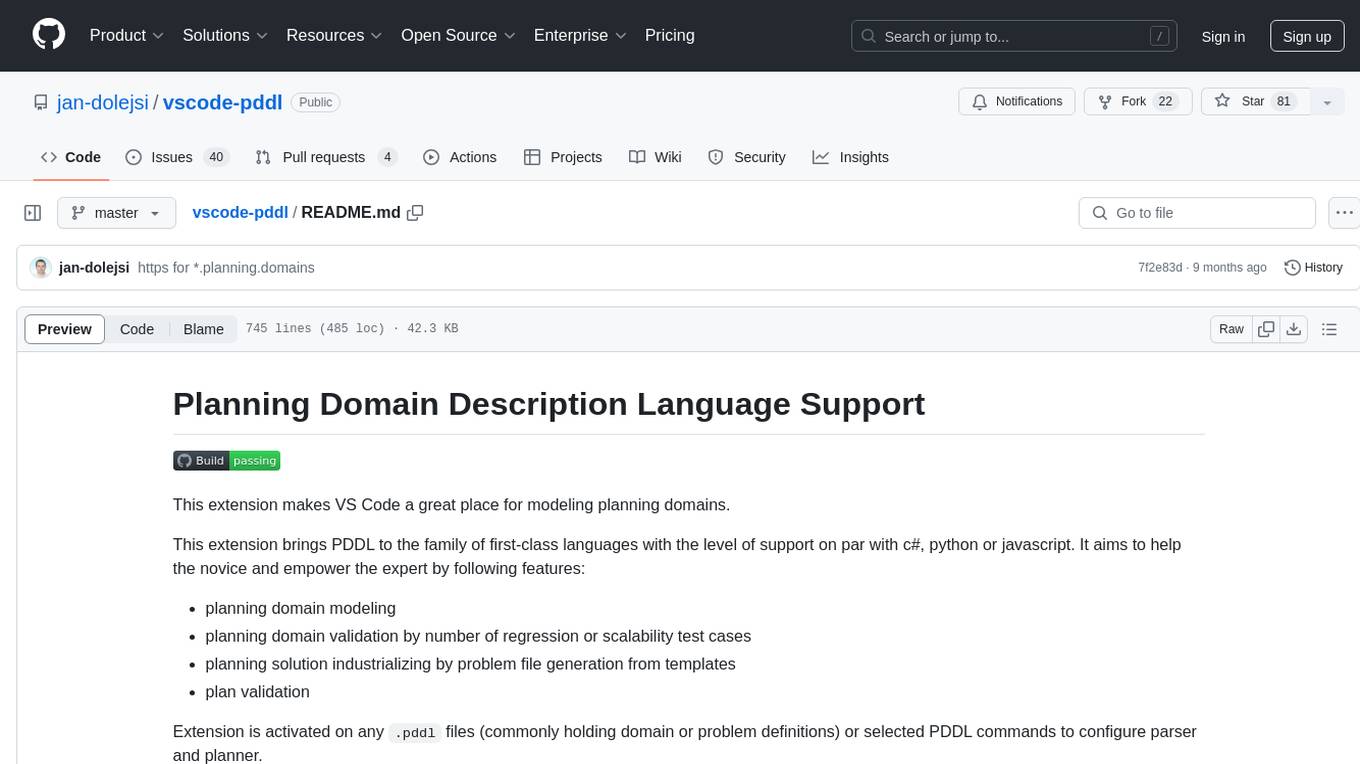
vscode-pddl
The vscode-pddl extension provides comprehensive support for Planning Domain Description Language (PDDL) in Visual Studio Code. It enables users to model planning domains, validate them, industrialize planning solutions, and run planners. The extension offers features like syntax highlighting, auto-completion, plan visualization, plan validation, plan happenings evaluation, search debugging, and integration with Planning.Domains. Users can create PDDL files, run planners, visualize plans, and debug search algorithms efficiently within VS Code.
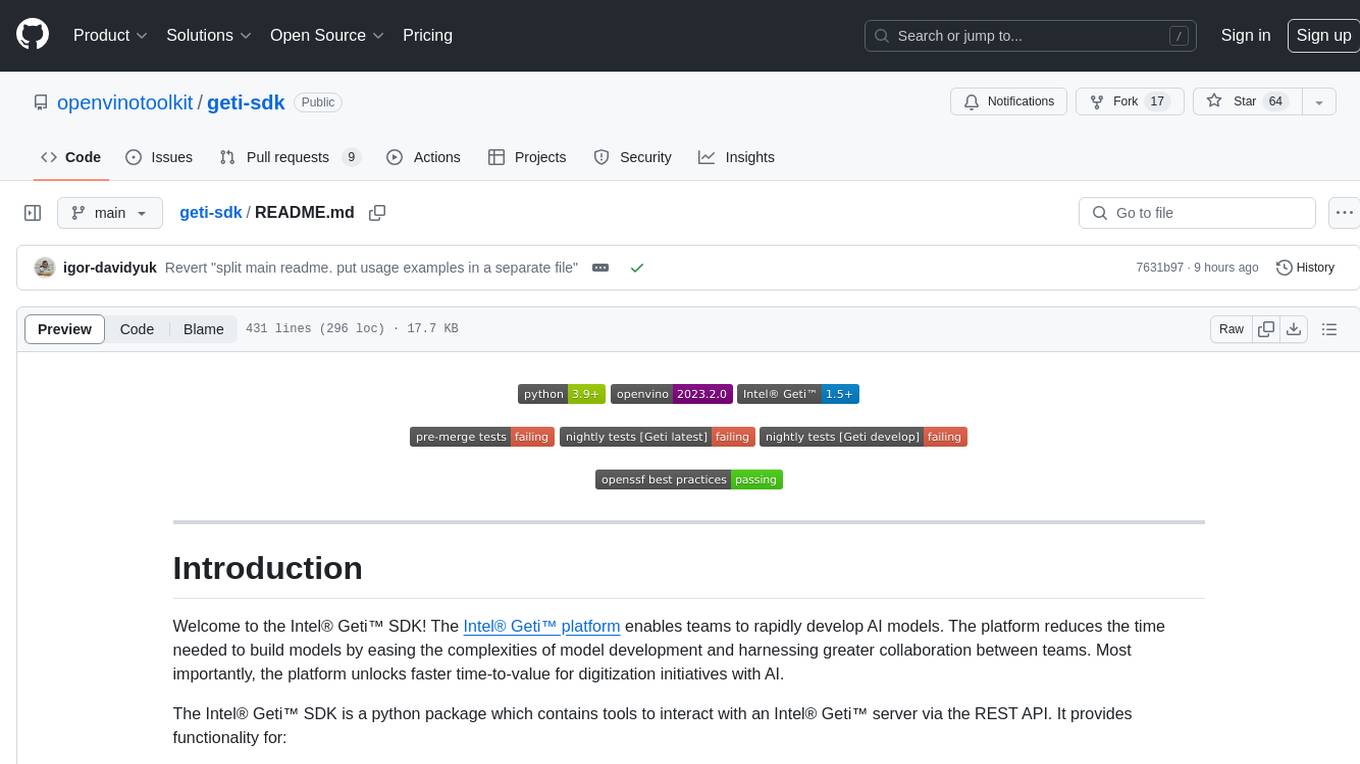
geti-sdk
The Intel® Geti™ SDK is a python package that enables teams to rapidly develop AI models by easing the complexities of model development and enhancing collaboration between teams. It provides tools to interact with an Intel® Geti™ server via the REST API, allowing for project creation, downloading, uploading, deploying for local inference with OpenVINO, setting project and model configuration, launching and monitoring training jobs, and media upload and prediction. The SDK also includes tutorial-style Jupyter notebooks demonstrating its usage.
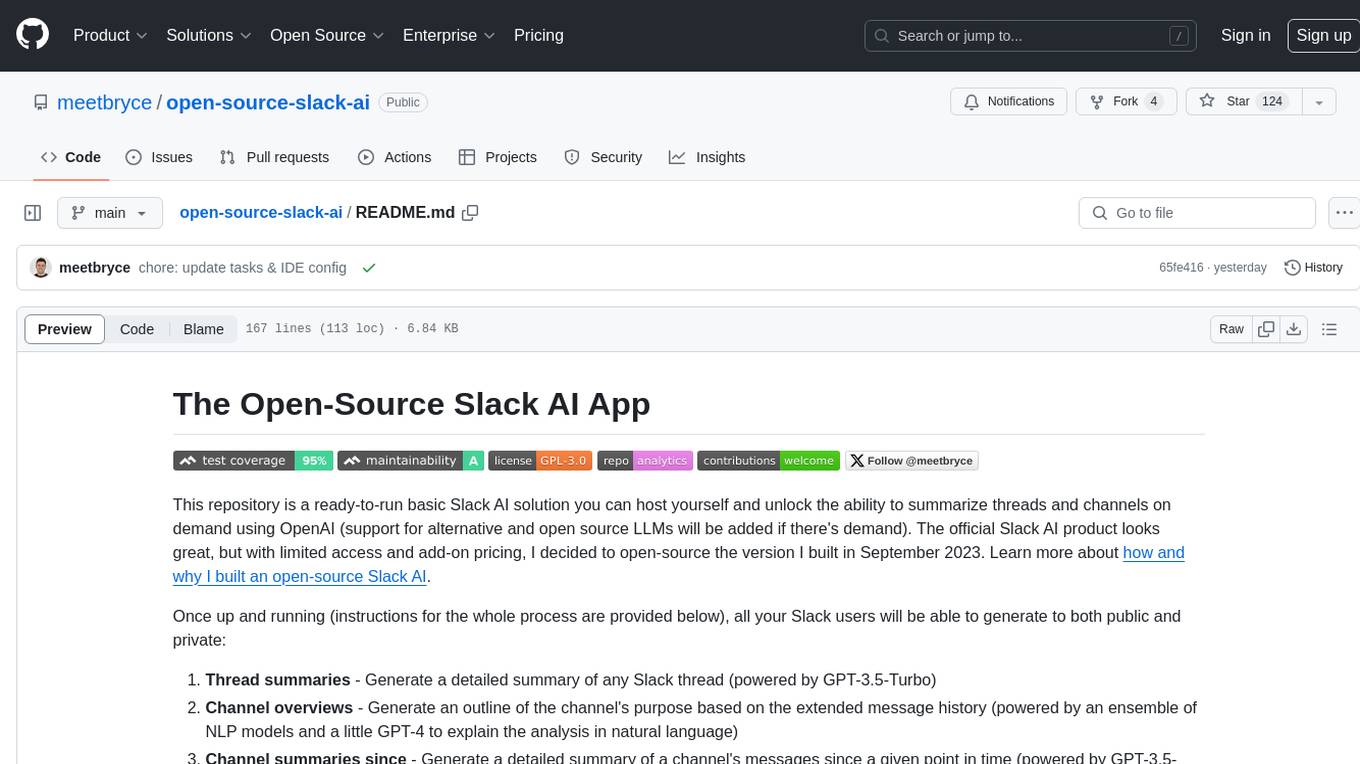
open-source-slack-ai
This repository provides a ready-to-run basic Slack AI solution that allows users to summarize threads and channels using OpenAI. Users can generate thread summaries, channel overviews, channel summaries since a specific time, and full channel summaries. The tool is powered by GPT-3.5-Turbo and an ensemble of NLP models. It requires Python 3.8 or higher, an OpenAI API key, Slack App with associated API tokens, Poetry package manager, and ngrok for local development. Users can customize channel and thread summaries, run tests with coverage using pytest, and contribute to the project for future enhancements.
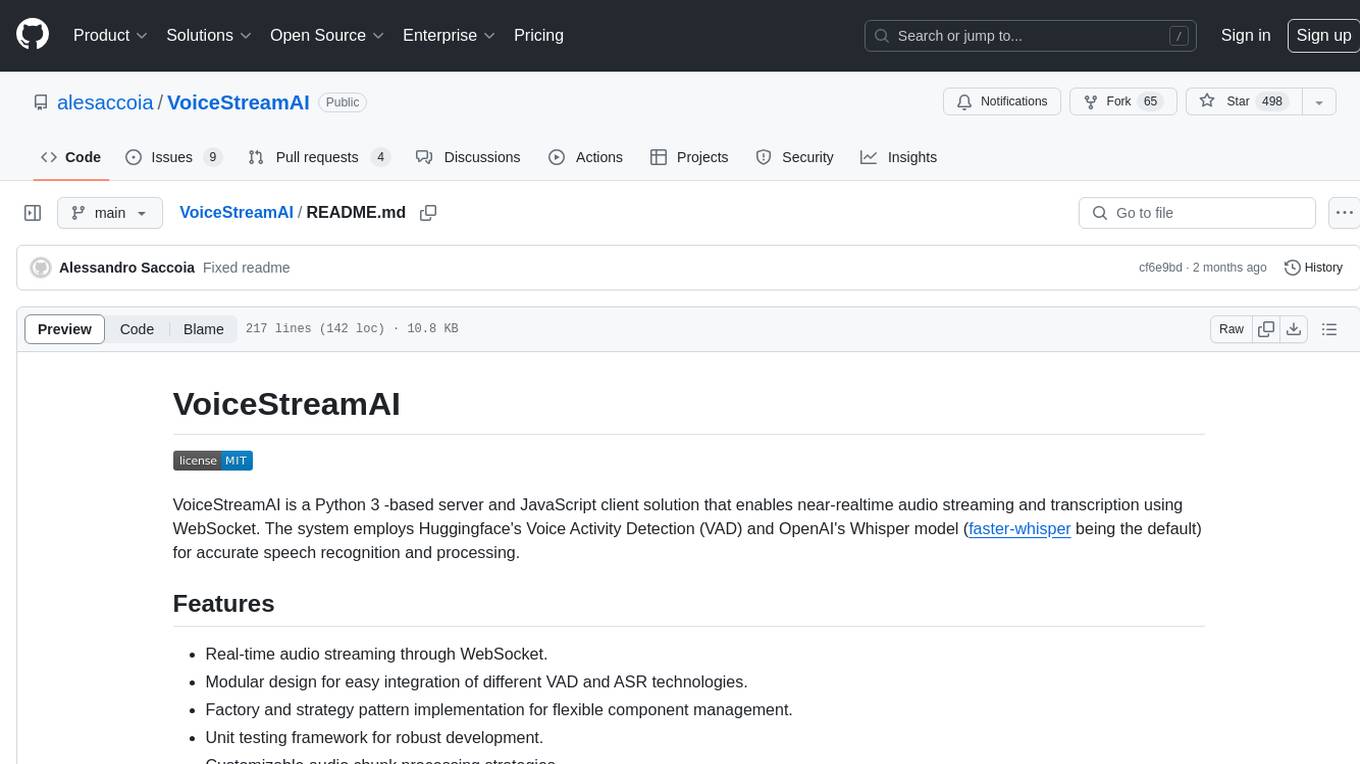
VoiceStreamAI
VoiceStreamAI is a Python 3-based server and JavaScript client solution for near-realtime audio streaming and transcription using WebSocket. It employs Huggingface's Voice Activity Detection (VAD) and OpenAI's Whisper model for accurate speech recognition. The system features real-time audio streaming, modular design for easy integration of VAD and ASR technologies, customizable audio chunk processing strategies, support for multilingual transcription, and secure sockets support. It uses a factory and strategy pattern implementation for flexible component management and provides a unit testing framework for robust development.
For similar tasks

AIOC
AIOC is an All-in-one-Cable for Ham Radio enthusiasts, providing a cheap and hackable digital mode USB interface with features like sound-card, virtual tty, and CM108 compatible HID endpoint. It supports various software and tested radios for functions like programming, APRS, and Dual-PTT HTs. Users can fabricate and assemble the AIOC using specific instructions, and program it using STM32CubeIDE. The tool can be used for tasks like programming radios, asserting PTT, and accessing audio data channels. Future work includes configurable AIOC settings, virtual-PTT, and virtual-COS features.
For similar jobs

AIOC
AIOC is an All-in-one-Cable for Ham Radio enthusiasts, providing a cheap and hackable digital mode USB interface with features like sound-card, virtual tty, and CM108 compatible HID endpoint. It supports various software and tested radios for functions like programming, APRS, and Dual-PTT HTs. Users can fabricate and assemble the AIOC using specific instructions, and program it using STM32CubeIDE. The tool can be used for tasks like programming radios, asserting PTT, and accessing audio data channels. Future work includes configurable AIOC settings, virtual-PTT, and virtual-COS features.
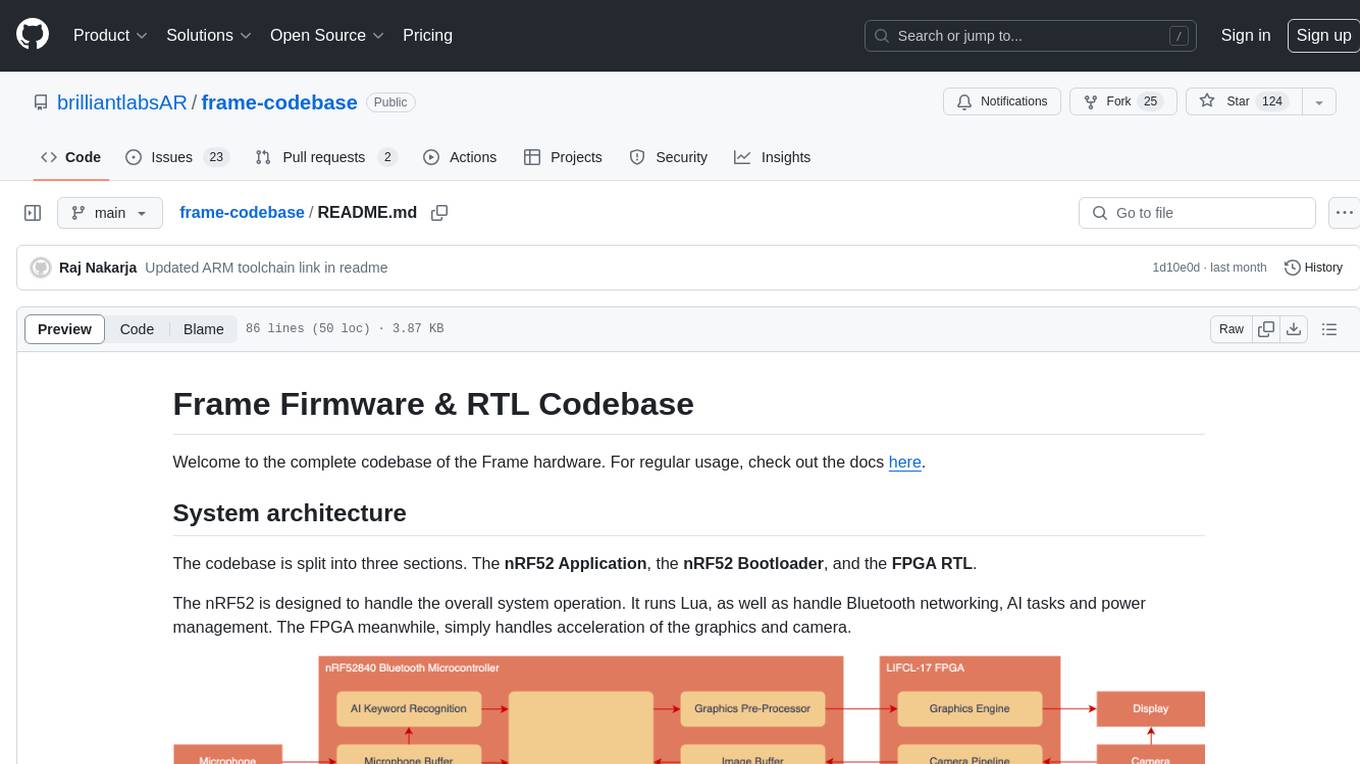
frame-codebase
The Frame Firmware & RTL Codebase is a comprehensive repository containing code for the Frame hardware system architecture. It includes sections for nRF52 Application, nRF52 Bootloader, and FPGA RTL. The nRF52 handles system operation, Lua scripting, Bluetooth networking, AI tasks, and power management, while the FPGA accelerates graphics and camera processing. The repository provides instructions for firmware development, debugging in VSCode, and FPGA development using tools like ARM GCC Toolchain, nRF Command Line Tools, Yosys, Project Oxide, and nextpnr. Users can build and flash projects for nRF52840 DK, modify FPGA RTL, and access pre-built accelerators bundled in the repo.
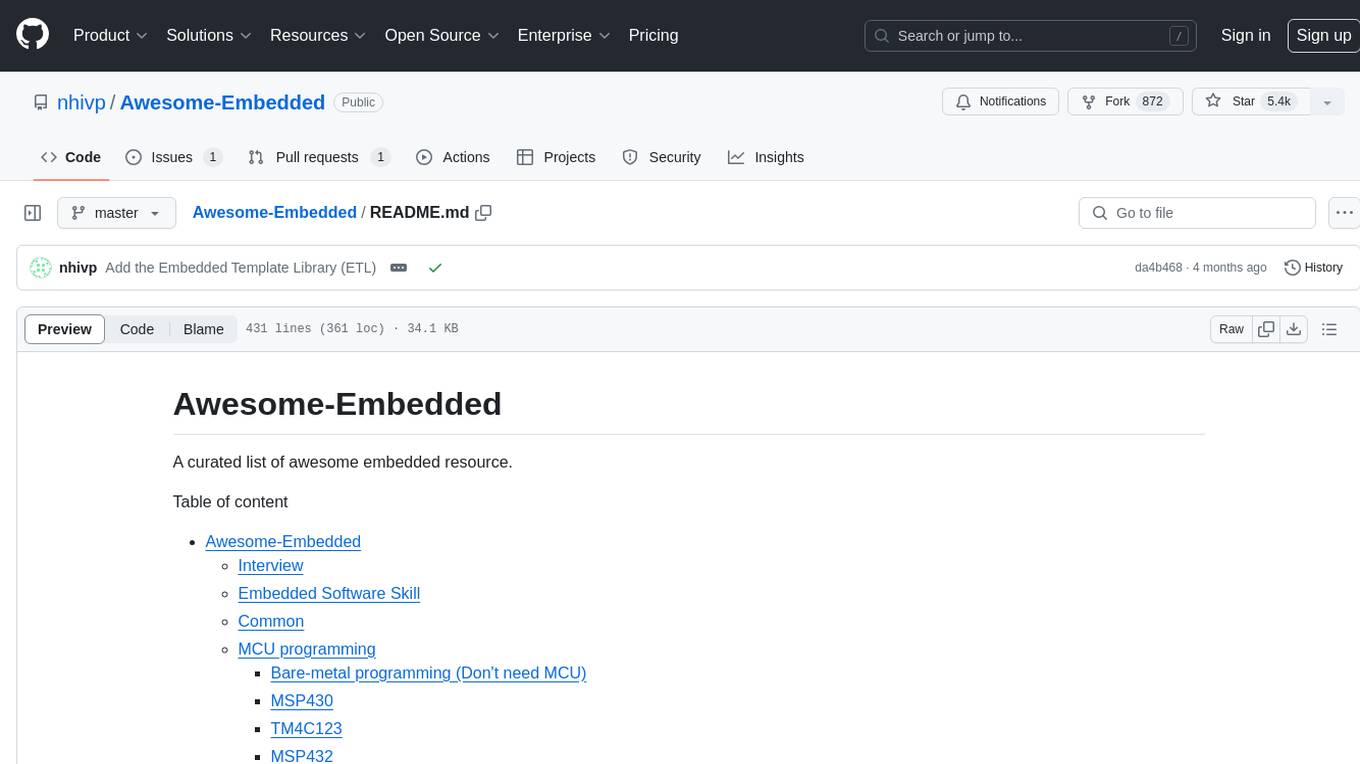
Awesome-Embedded
Awesome-Embedded is a curated list of resources for embedded systems enthusiasts. It covers a wide range of topics including MCU programming, RTOS, Linux kernel development, assembly programming, machine learning & AI on MCU, utilities, tips & tricks, and more. The repository provides valuable information, tutorials, and tools for individuals interested in embedded systems development.
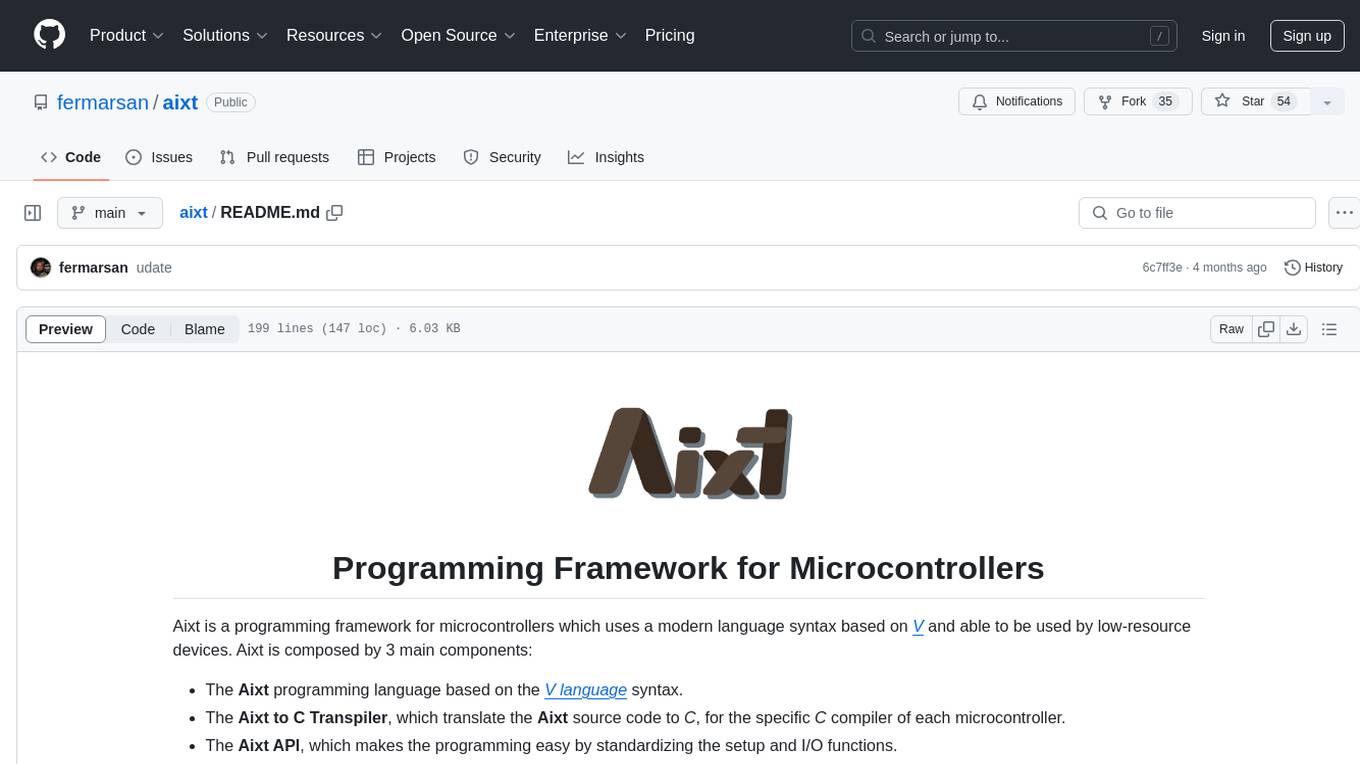
aixt
Aixt is a programming framework for microcontrollers using a modern language syntax based on V, with components including the Aixt programming language, Aixt to C Transpiler, and Aixt API. It is designed to be modular, allowing easy incorporation of new devices and boards through a TOML configuration file. The Aixt to C Transpiler translates Aixt source code to C for specific microcontroller compilers. The Aixt language implements a subset of V with differences in variables, strings, arrays, default integers size, structs, functions, and preprocessor commands. The Aixt API provides functions for digital I/O, analog inputs, PWM outputs, and serial ports.
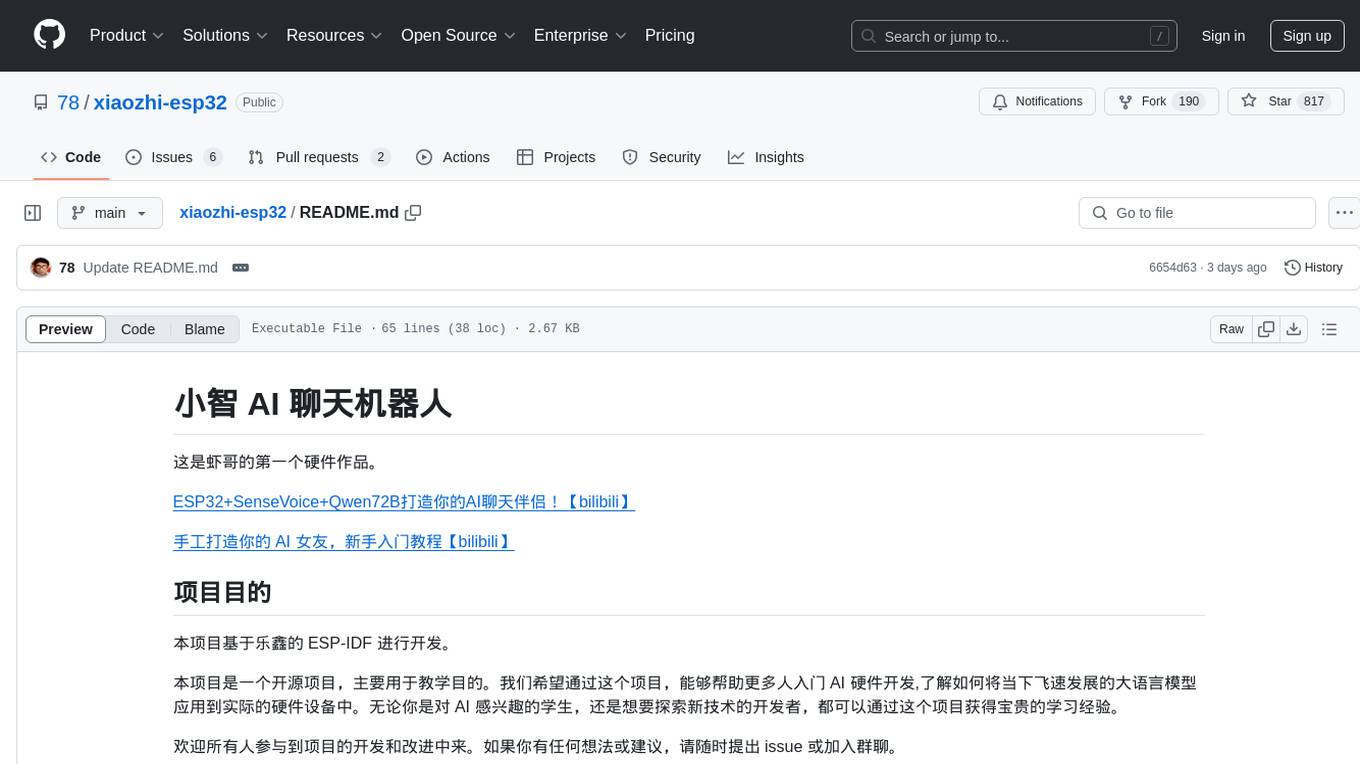
xiaozhi-esp32
The xiaozhi-esp32 repository is the first hardware project by Xia Ge, focusing on creating an AI chatbot using ESP32, SenseVoice, and Qwen72B. The project aims to help beginners in AI hardware development understand how to apply language models to hardware devices. It supports various functionalities such as Wi-Fi configuration, offline voice wake-up, multilingual speech recognition, voiceprint recognition, TTS using large models, and more. The project encourages participation for learning and improvement, providing resources for hardware and firmware development.
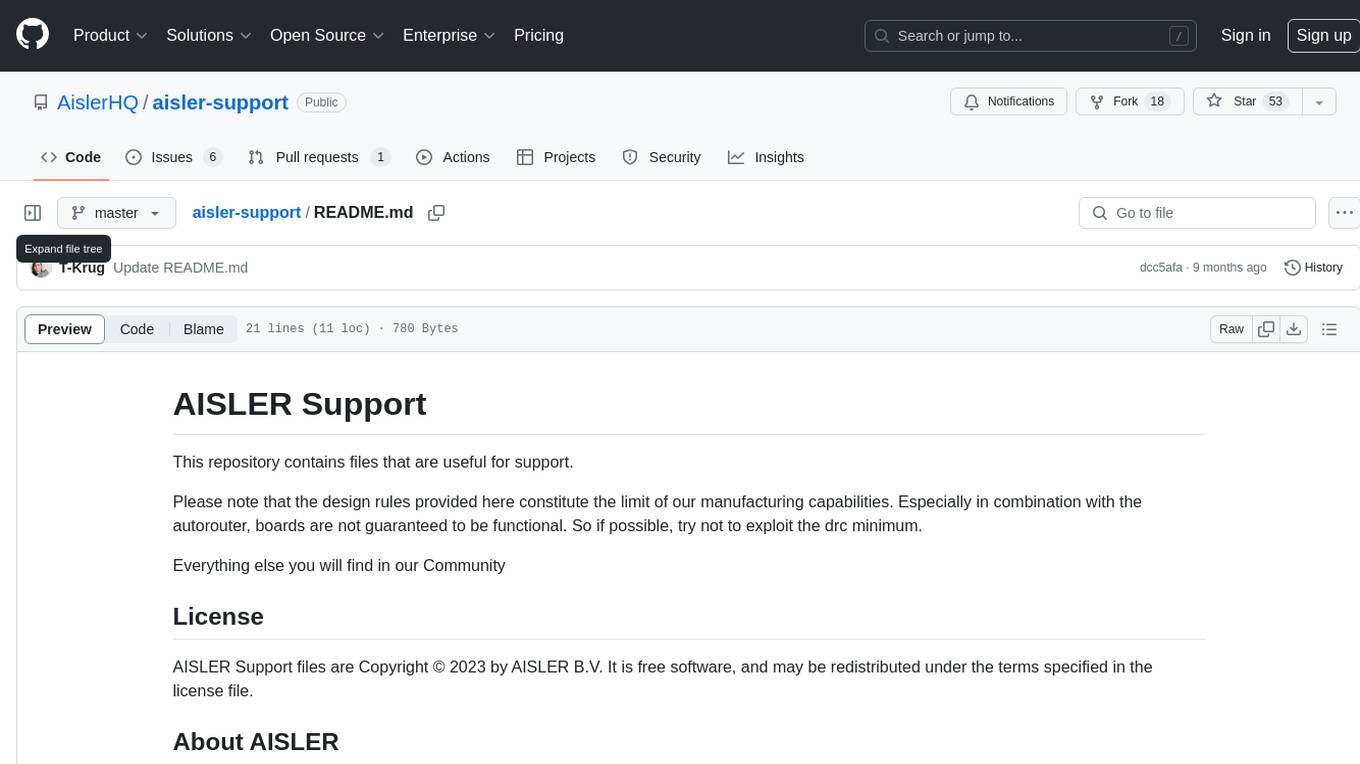
aisler-support
AISLER Support repository contains files useful for support. Design rules provided here limit manufacturing capabilities. Boards may not be functional with autorouter. Explore more in Community. AISLER Support files are Copyright © 2023 by AISLER B.V. Free software under specified license terms. Visit AISLER for industry quality and affordable PCBs.







